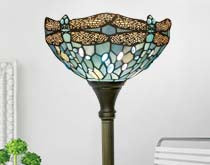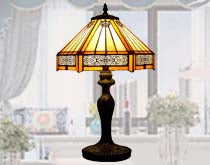How do I Identify an Art Deco Lamp?
Art Deco lamps are known for their timeless charm and unique style, representing the creativity of the Art Deco movement. If you've come across one and want to know how to spot its distinct features, this guide is here to help. We'll explore the details of identifying an Art Deco lamp and reveal what sets it apart in the lighting world.
Related reading: Tiffany Lamps: Art Deco or Art Nouveau
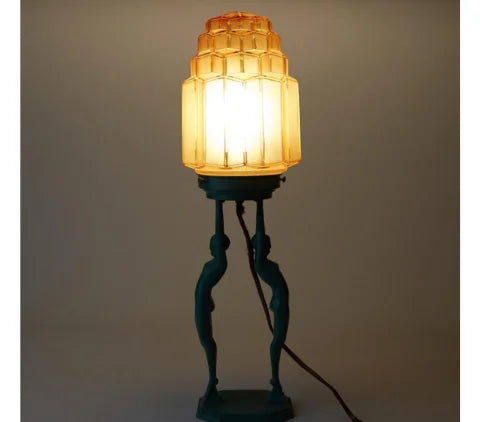
Know about the Materials Used
To identify an Art Deco lamp, you must know the materials commonly used in the Art Deco era. These materials shaped the lamp's look and captured the era's essence. Let's explore the materials that tell the story of the Art Deco era, aiding you in spotting these classic lamps' authenticity.
1. Glass
Art Deco lamps frequently use elegant glass details that add sophistication. These glass parts are essential for the lamp's overall style.
Colored Glass: Art Deco lampshades feature colorful glass. Vibrant shades such as deep blues, rich reds, and striking greens enhance their luxurious appeal. Some lamps use stained glass panels, producing captivating visual effects when lit. On that note, you can also check out this blog: How to identify real stained glass table lamp in 2022?
Frosted Glass: Frosted or satin glass is commonly used. It diffuses light softly, casting a warm and inviting ambiance in the room.
Geometric Patterns: Art Deco lamps typically have glass shades with detailed geometric patterns. These patterns, like zigzags, sunbursts, and stylized florals, showcase the movement's love for geometric design.
2. Metal
Metal was crucial in crafting Art Deco lamps, giving them a sleek and modern look. Various metals were popular during that time.
Chrome: Chrome plating was widely used to achieve a lustrous, mirror-like finish. It added a touch of glamour to lamp bases and other metal elements, reflecting the Art Deco movement's obsession with luxury.
Brass: Brass, with its warm, golden color, was a versatile option. It could be polished for a shiny look or aged for a vintage appearance, offering various design options. Brass was often used for lamp bases and decorative accents.
Nickel: Nickel, known for its silvery finish, also appeared in Art Deco lamp designs. Its sleek, modern appearance matched the movement's emphasis on modern beauty.
3. Bakelite
Bakelite, an early form of plastic, was another material commonly used in Art Deco lamp construction. It was celebrated for its ability to mimic the appearance of luxurious materials like ivory or tortoiseshell, making it an economical choice for Art Deco designers.
Switches and Handles: Bakelite was often employed for switches, handles, and other small details on Art Deco lamps. Its malleability allowed for intricate designs and smooth finishes.
4. Wood
While metals and glass were dominant, wood also played a role in some Art Deco lamps. Wood added a touch of warmth to the otherwise sleek and modern designs.
Exotic Woods: Exotic woods like mahogany, ebony, and rosewood were occasionally used for lamp bases or accents. Their rich colors and intricate grain patterns complemented the Art Deco aesthetic.
5. Fabric and Textiles
Art Deco lamps didn't rely solely on hard materials. Fabric shades were also employed to soften and diffuse the light, adding an element of comfort to the design.
Silk: Silk was a popular lampshade choice during the Art Deco era. It created a luxurious and inviting atmosphere when the lamp was illuminated.
Patterned Fabrics: Certain Art Deco lamps had fabric shades with vivid patterns that matched the geometric designs found in the glass and metal parts.
The materials in Art Deco lamps reveal the time they come from. Glass, with its colored, frosted, and patterned options, shows the dedication to style and new ideas. Metal, especially chrome and brass, represents the modern and luxurious side of Art Deco. Bakelite, an early plastic, highlights the movement's ability to use new materials. Wood and fabric, though less common, added to the appeal of Art Deco lamps. Knowing about these materials helps you recognize the charm of an Art Deco lamp and its special role in design history.
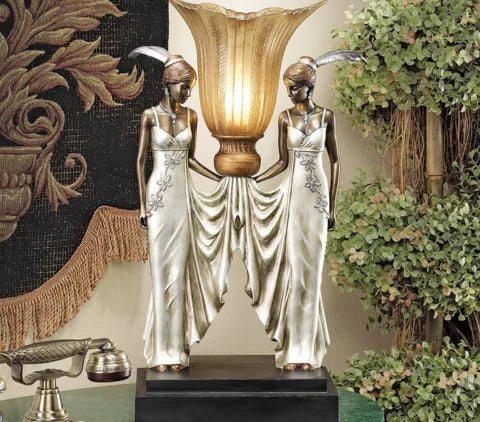
Identify Geometry in Every Detail
When you spot an Art Deco lamp, notice the strong use of geometry in every part. The Art Deco style loved precise shapes and patterns; you can easily see this in Art Deco lamps. Let's look at how geometry is key to identifying these lamps.
1. Angular Shapes
Art Deco lamps often use sharp angles to create a striking look. These angular shapes are a clear indicator of an Art Deco design. You'll frequently see square and rectangular forms in the lamp bases and shades, giving a sense of stability and order.
For example, picture a table lamp with a rectangular base adorned with sleek vertical lines that resemble skyscrapers reaching toward the sky. This design reflects the Art Deco era's fascination with modern urban life and its vibrant energy. Similarly, square shades with crisp corners and clean lines were commonly used. These angular elements add a feeling of structure and purpose to Art Deco lamps.
2. Geometric Patterns
Art Deco lamps feature intricate geometric patterns that are visually captivating. These patterns include zigzags, chevrons, sunbursts, and repeating geometric motifs. They showcase the remarkable craftsmanship and attention to detail of Art Deco designers.
An example is a floor lamp with a sunburst pattern emanating from its central stem. This bold design choice adds a luxurious touch and symbolizes the optimism and energy of the Art Deco era. Likewise, table lamps with zigzag patterns etched into their metal bases create a sense of motion and rhythm, capturing the viewer's attention and fascination.
3. Symmetry
Symmetry is crucial when identifying Art Deco lamps. Whether it's the lamp's overall shape or the balance of its geometric features, harmony is a core principle in Art Deco style.
Imagine a pendant chandelier with multiple arms holding a geometric glass shade. These arms are carefully arranged to create a symmetrical and elegant design. The dedication to symmetry extends to even the smallest details, like where decorative elements are positioned and how geometric patterns align.
4. Various Shapes
Art Deco lamps feature a variety of shapes, from squares and rectangles to circles, ovals, trapezoids, and even hexagons. These shapes are cleverly combined to create visually stunning and well-balanced lamps.
For example, picture a chandelier with hexagonal glass shades suspended gracefully from its arms. With their six equal sides, the hexagons bring a sense of order and completeness to the design. Alternatively, consider a desk lamp with a circular base and an elongated oval shade, showcasing Art Deco's love for symmetry and sleek forms.
5. Geometry
In Art Deco lamps, geometry serves both beauty and practicality. These geometric designs aren't just for looks; they also have a useful function in providing precise lighting. For instance, table lamps with adjustable metal shades, shaped like cones or cylinders, let you aim light where you need it, seamlessly blending style and usefulness.
In summary, geometry is a defining feature of Art Deco lamps. Angular shapes, intricate patterns, symmetry, and various forms come together to create these iconic lights. The meticulous attention to geometric design showcases the craftsmanship and artistic vision of the Art Deco era. When you encounter an Art Deco lamp adorned with these geometric elements, you're witnessing lighting history and experiencing a design masterpiece that continues to captivate and inspire.
Streamlined Silhouettes
Streamlined silhouettes define Art Deco lamps. They capture the era's essence of simplicity, elegance, and modernity. Knowing about these silhouettes is important for recognizing Art Deco lamps.
The Essence of Streamlined Silhouettes
Art Deco lamps have sleek and simple shapes inspired by the idea that less is more. This design reacted to the ornate styles of the past, like Art Nouveau, and aimed to embrace clean lines and geometric shapes that symbolized progress in the early 1900s.
Clean Lines and Minimalism
At the core of streamlined silhouettes are clean lines and minimalistic design principles. Art Deco lamps often feature straight edges, sharp angles, and no excessive decoration. The emphasis here is on simplicity and practicality, moving away from the complex and ornate designs of the past.
Simple Bases
One of the critical areas where streamlined silhouettes shine is the lamp's base. Art Deco lamp bases are simple but stylish. They may be simple geometric shapes like cylinders, squares, or rectangles. These bases are designed to provide stability and complement the overall minimalist aesthetic of the lamp.
Innovative Materials
The innovative use of materials often enhances streamlined silhouettes in Art Deco lamps. The era shifted towards modern materials like chrome, nickel, and Bakelite. These materials contributed to the lamps' sleek appearance and reflected the spirit of progress and industrialization.
Sleek Lampshades
The lampshades in Art Deco lamps also contribute to the streamlined silhouette. They tend to be sleek and angular, aligning with the overall geometry of the design. Glass shades, in particular, are common in Art Deco lamps. They might have subtle patterns that make the lamp look nicer. When it comes to glass lampshades, you have to mention the Tiffany stained glass lamp shades, but it belongs to the Deco and Art Nouveau styles.
Balanced Proportions
Symmetry and balance define sleek shapes. You'll often find perfectly balanced features when you examine an Art Deco lamp. This sense of equilibrium adds to the overall sense of harmony in the design. It's not uncommon to see lamps with matching elements on either side, reinforcing the importance of symmetry.
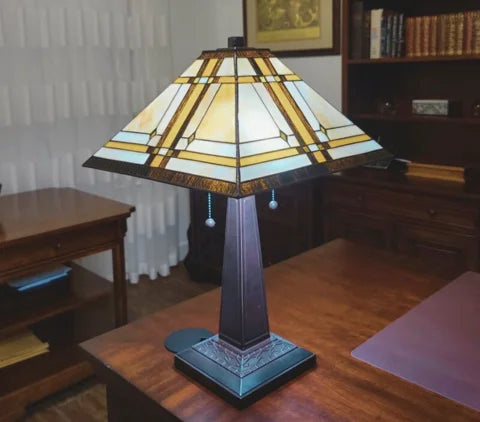
How to Identify Streamlined Silhouettes in Art Deco Lamps
Recognizing streamlined silhouettes in Art Deco lamps involves a keen eye for the following elements:
- Clean Lines:Look for straight, uncluttered lines in the lamp's base and overall design.
- Minimalistic Bases: Focus on the lamp's base, which is often simple and geometric.
- Angular Shades: Pay attention to angular and sleek lampshade designs that complement the lamp's geometry.
- Symmetry: Check for symmetry and balance in the lamp's features.
- Innovative Materials: Be aware of modern materials like chrome, nickel, and Bakelite, which contribute to the lamp's streamlined appearance.
In summary, streamlined silhouettes are characteristics of Art Deco lamps, capturing the spirit of the era's emphasis on simplicity, elegance, and modernity. These lamps are not just sources of illumination; they are timeless pieces of design history that continue to inspire admiration for their sleek and harmonious aesthetics. The next time you encounter an Art Deco lamp, you'll be equipped with the knowledge to appreciate its streamlined silhouette.
Attention to Detail
When identifying an Art Deco lamp, careful detail is one of the most critical aspects to pay attention to. The Art Deco movement was renowned for its dedication to precision and craftsmanship, and this focus on detail is reflected in the lamps created during this era. This section will explore the areas you should examine when trying to identify an Art Deco Lamp:
Carefully examine Metalwork
One of the features of Art Deco lamps is the intricate metalwork that adorns them. These lamps often feature bases, stands, and other chrome, brass, or nickel components. What sets these metal elements apart is the precision and creativity invested in their design.
1. Geometric Patterns: Art Deco is synonymous with geometric shapes, and you'll often find lamps with metal bases and accents adorned with stunning geometric patterns. These patterns can include zigzags, chevrons, sunbursts, and intricate grids. Each line, angle, and curve is carefully crafted to create a visually striking effect.
2. Stylized Figures: Some Art Deco lamps showcase stylized figures or motifs as part of their metalwork. These figures could be representations of people, animals, or abstract forms.
What's important to note is the artistic flair and attention to detail that goes into rendering these figures, often with a streamlined and modern twist.
3. Polished Surfaces: Art Deco lamps frequently feature polished metal surfaces that enhance their aesthetic appeal and highlight the craftsmanship involved. The mirror-like finish reflects the dedication to creating flawless, lustrous exteriors.
Take note of Glasswork
The glasswork is another area where Art Deco lamps shine in attention to detail. Glass shades and globes are significant in defining the lamp's overall look and feel.
1. Geometric Patterns: Just as with metalwork, geometric patterns are common in the glasswork of Art Deco lamps. These patterns are often etched or frosted onto the glass, creating a captivating interplay of light and shadow. The precision with which these patterns are executed is a testament to the artisan's skill.
2. Colored Glass: Art Deco lamps sometimes incorporate colored glass, which adds depth and richness to the design. The choice of colors and how they are applied and blended reflects a keen sense of aesthetics. You might encounter shades in bold, contrasting colors or more harmonious tones.
3. Layered Designs: Some Art Deco lamps feature layered or tiered glass shades, creating a sense of depth and dimension. These layers are carefully crafted to fit seamlessly together, showcasing the meticulous attention to detail.
Sculptural Elements
Art Deco lamps are not just sources of illumination; they are sculptural works of art in their own right. Pay attention to the sculptural elements that often grace these lamps.
1. Figural Sculptures: Some Art Deco lamps incorporate figurative sculptures into their design. These sculptures could be representations of people, animals, or mythological figures. The level of detail in these sculptures is remarkable, capturing intricate facial expressions, poses, and clothing.
2. Floral and Organic Motifs: Art Deco drew inspiration from nature, and you'll find lamps adorned with floral and organic motifs. These motifs are sculpted with precision, showcasing the beauty and symmetry found in the natural world.
3. Abstract Forms: For those who appreciate abstract art, Art Deco lamps often feature abstract sculptural elements. These forms can be open to interpretation, allowing viewers to find their own meaning and appreciation in the details.
Functional Elegance
Beyond the purely decorative aspects, Art Deco lamps also exhibit attention to detail in their functionality.
1. Switches and Controls: The switches and controls on Art Deco lamps are often designed with a sense of style. Even these functional components showcase the movement's dedication to aesthetics with elegant shapes and materials.
2. Cord and Wiring: While not immediately visible, the wiring and cord of an Art Deco lamp are usually well-organized and not easily visible, adding to the overall tidiness and sophistication of the piece.
When identifying an Art Deco lamp, it's vital to appreciate the intricate craftsmanship that defines these timeless pieces. The meticulous metalwork, intricate glass designs, sculptural elements, and functional features all showcase the dedication to aesthetics and artistry during the Art Deco era. Focusing on these details will deepen your understanding and admiration for the exquisite beauty of Art Deco lamps, making it easier to recognize and cherish them as exceptional works of art and design.
Related: how to identify a tiffany lamp
Conclusion
In conclusion, identifying an Art Deco lamp is a skill that requires an artistic eye. It involves noticing the abundant materials, embracing the geometric aesthetics, appreciating the smooth and elegant contours, and admiring the meticulous craftsmanship to the smallest detail. These lamps are more than just sources of light; they are enduring masterpieces that consistently charm enthusiasts with their timeless elegance and sophistication. With this knowledge at your fingertips, you'll be fully equipped to confidently and unmistakably identify any Art Deco lamp you encounter.












